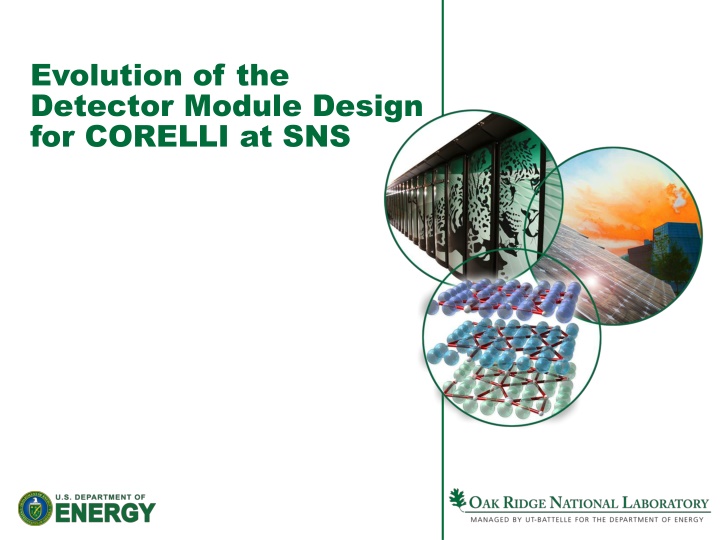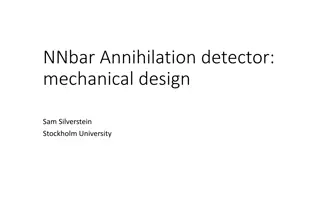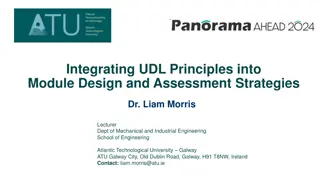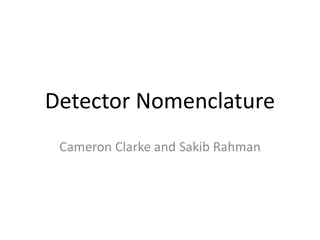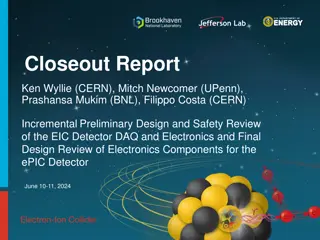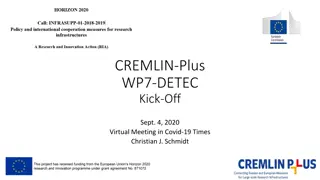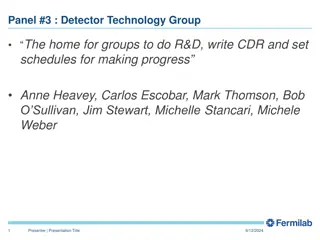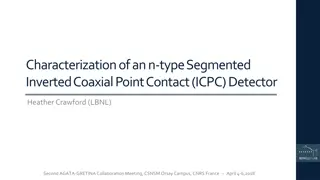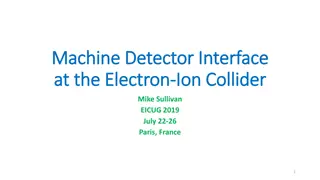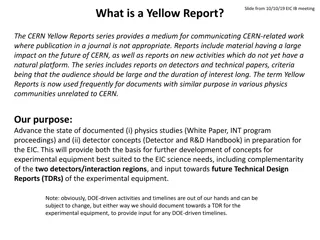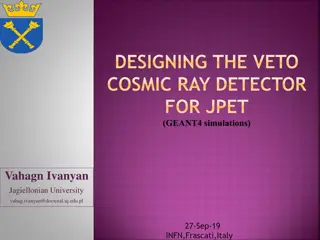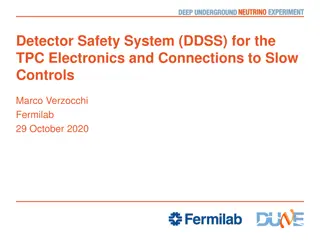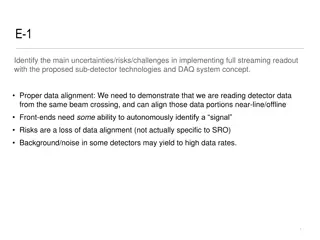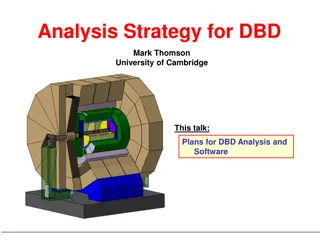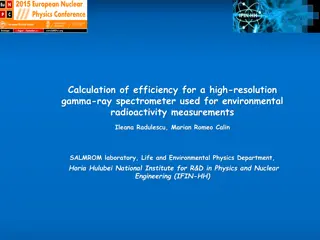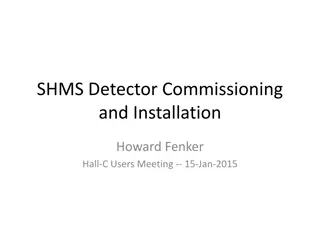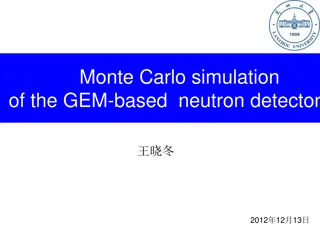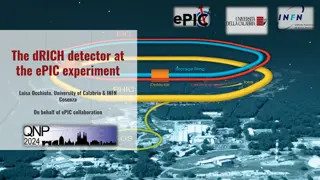Evolution of CORELLI Detector Module Design
This article discusses the evolution of the detector module design for CORELLI at SNS, detailing the challenges faced, working solutions, and the unique features of the Corelli instrument. From outlining the talk to the instrument layout and detector array specifications, the advancements in detector technology for studying diffuse scattering are explored. Additionally, the absence of an isolation valve for Corelli's vacuum system is highlighted, requiring unique operational considerations.
Download Presentation

Please find below an Image/Link to download the presentation.
The content on the website is provided AS IS for your information and personal use only. It may not be sold, licensed, or shared on other websites without obtaining consent from the author.If you encounter any issues during the download, it is possible that the publisher has removed the file from their server.
You are allowed to download the files provided on this website for personal or commercial use, subject to the condition that they are used lawfully. All files are the property of their respective owners.
The content on the website is provided AS IS for your information and personal use only. It may not be sold, licensed, or shared on other websites without obtaining consent from the author.
E N D
Presentation Transcript
Evolution of the Detector Module Design for CORELLI at SNS
Outline of Talk Introduction to Corelli and Corelli Detectors Why the Need for a Different Detector Design Design Challenges Working Solutions Final Comments 2 Managed by UT-Battelle for the U.S. Department of Energy Presentation_name
What is CORELLI? aka Elastic Diffuse Scattering Spectrometer (managed as part of the SING II project) Corelli is a statistical chopper spectrometer designed and optimized to probe local disorder through diffuse scattering from single crystals It combines the high efficiency of white beam Laue diffraction with energy discrimination by modulating the beam with a statistical correlation chopper Corelli will be the first instrument in the world dedicated to the study of diffuse scattering with energy discrimination 3 Managed by UT-Battelle for the U.S. Department of Energy Presentation_name
CORELLI is located on BL9 at SNS Proton Beam Direction Bridge to CLO Corelli BL9 4 Managed by UT-Battelle for the U.S. Department of Energy Presentation_name
Instrument Layout Moderator C/L Sample C/L Detector C/L 20 m 2.5 m Choppers Sample Scattering Vessel 5 Managed by UT-Battelle for the U.S. Department of Energy Presentation_name
Detector Array Detector Array Frame Sample Scattering Vessel 3 rows of He-3 Filled Linear Position Sensitive Detectors (GE Reuter-Stokes) 1.27 cm diameter x 83.9 cm active length, Spatial Resolution 1 cm x 1 cm 16 tubes per module, 30 modules per row for a total of 1440 tubes Vertical Range - 28.5o to + 28.5o Horizontal Range - 23o to + 152o Initial phase to consist of 38 modules, mostly located along middle row 6 Managed by UT-Battelle for the U.S. Department of Energy Presentation_name
No Isolation Valve for Corelli No room to fit valve to isolate sample vacuum space from detector vacuum space Thus, we need to vent and pump entire vacuum vessel with each sample change 7 Managed by UT-Battelle for the U.S. Department of Energy Presentation_name
... Resulting in a Few Design Challenges Compared with the ARCS detector 1. To reduce pump down time, detector electronics need to be placed inside compartment which is separate from the vacuum space ARCS design open to vacuum 2. 15 Watts per module twice that of ARCS 8-pack design 3. Electronic circuit board designs (preamplifiers in particular) require temperatures to be stable to within 1-2 oC for reliable performance same as for ARCS but harder to achieve for Corelli due to periodic vent/vacuum cycles ARCS 8-pack detector module 2.54 cm dia. x 100 cm long tubes 8 Managed by UT-Battelle for the U.S. Department of Energy Presentation_name
Design Challenge #1 Met Detector Electronics Tray Assembly Electronics Tray Fits in Compartment Behind Detector Tubes 9 Managed by UT-Battelle for the U.S. Department of Energy Presentation_name
Design Challenge #2 (15 Watts of Power) Two Options Considered: Active Cooling (forced air flow through electronics compartment) Cooling Lines Passive Cooling via heat sinks and black surfaces Painted Black Inside and Out 10 Managed by UT-Battelle for the U.S. Department of Energy Presentation_name
Thermal Imaging Identified Hot Spots for Placement of Heat Sinks 11 Managed by UT-Battelle for the U.S. Department of Energy Presentation_name
Custom Vacuum Chamber Built to Simulate Vent/Vacuum Cycles in Lab Atm to <1E-4 Torr in 30 min Cooling lines connected to house air (and flow controllers) Circuit boards have built in thermal sensors Also used TC gauges to measure surface temperatures Power and signal cables to quantify stability of detector electronics 12 Managed by UT-Battelle for the U.S. Department of Energy Presentation_name
Design Challenge #2 Met 60 We targeted < 60 oC to be consistent with ARCS design 50 Temperature oC 40 30 20 Able to adequately cool with reasonable air flow (0.5 CFM) 10 0 0 20 40 60 80 100 120 Time in hours Also able to passively cool with black surfaces, modest repositioning of boards, and application of heat sinks 60 50 Temperatureo C 40 30 20 10 0 0 20 40 60 80 100 120 Time in hours 13 Managed by UT-Battelle for the U.S. Department of Energy Presentation_name
Design Challenge #3 (temperature instability of preamps) Temperature stability during 2 hour vent cycle was not achieved 54 53 Vent Begins 52 Temperature oC 51 Instrument team needs to be able to take data once acceptable vacuum is reached (est. 2-3 hours) 50 Repump Begins 49 48 47 46 45 Time constant to return to equilibrium temperatures > 24 hours 0 2 4 6 Time in Hours 14 Managed by UT-Battelle for the U.S. Department of Energy Presentation_name
Effect of Temperature Drift on Calculated Neutron Position Temperature drift of preamps is known to have detrimental effect on calculated event position tube center tube end 70 Change in Peak Position (mm) 60 Effect much more pronounced near tube ends than center 50 40 30 20 10 0 46 48 50 52 54 56 58 Temperature (oC) 15 Managed by UT-Battelle for the U.S. Department of Energy Presentation_name
Design Challenge #3 Met with Electronic Solution Preamplifier modification provides solution to peak shift problem tube center tube end 10 Change in Peak Position (mm) 8 6 capacitive decoupling of 4 2 1st stage op amp leads to 0 -2 exceptional peak stability -4 -6 with temperature change -8 -10 46 48 50 52 54 56 58 Temperature (oC) 16 Managed by UT-Battelle for the U.S. Department of Energy Presentation_name
Performance Stable Over Temperature Range Expected During Sample Change-Out 5 4 3 Change in FWHM (mm) 2 Vent Begins units 1 0 RED (mm) -1 GREEN (mm) -2 Change in Peak Position (mm) -3 BLUE (oC) -4 Repump Begins -5 -6 -7 -8 Change in Board Temperature After Vent (oC) -9 -10 0 1 2 3 4 5 6 7 8 Time After 2 Hour Vent to Atmosphere (hours) 17 Managed by UT-Battelle for the U.S. Department of Energy Presentation_name
Redesign of Preamplifier Boards Incorporated decoupling capacitor modification Improved protection circuitry to buffer against HV breakdown (Corona) Plug-in connectors to facilitate tray removal for maintenance 18 Managed by UT-Battelle for the U.S. Department of Energy Presentation_name
Upon further testing, vacuum group recommended removing all cabling from vacuum space Rear view of detector module showing NW25 bellows 19 Managed by UT-Battelle for the U.S. Department of Energy Presentation_name
Preparing for Installation The first phase of 38 Corelli detector modules are currently undergoing assembly and testing, on track for an early CD-4 finish date in Feb 2014 20 Managed by UT-Battelle for the U.S. Department of Energy Presentation_name
Detector Development Team Key Players Feng Ye Instrument Scientist George Rennich Lead Engineer Bill Turner Designer Mark Wendel Thermal Analysis Kevin Berry, Justin Beal Detector Development Vlad Sedov Electronics Development 21 Managed by UT-Battelle for the U.S. Department of Energy Presentation_name
